« Jasper to the Okanagan Valley - Summer 2008 | Main | Alberta again - Summer 2008 »
August 25, 2008
Southern British Columbia - Summer 2008
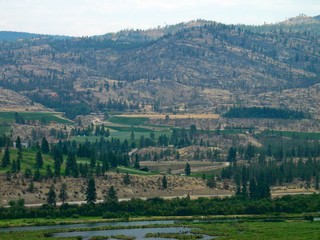 Oliver lists itself as the “Wine Capital of Canada” and with 10% of Canada’s wineries and the majority of BC’s vineyards nearby, it is well named. It actually is the northern tip of the American Great Basin Desert, which extends to Mexico. Irrigation, started in the 1920’s, has converted the desert-like valley floor and hillsides into orchards and vineyards.
Oliver lists itself as the “Wine Capital of Canada” and with 10% of Canada’s wineries and the majority of BC’s vineyards nearby, it is well named. It actually is the northern tip of the American Great Basin Desert, which extends to Mexico. Irrigation, started in the 1920’s, has converted the desert-like valley floor and hillsides into orchards and vineyards.
Every flat piece of land right from the river back to the hills is planted.
We stayed at a great small campground with huge willow trees, across the lake from the town of Oliver. We had hoped to visit the Citation RV manufacturing plant located there, but they were on an extended summer shutdown and speculation was that they might not reopen. We had also hoped to visit the Okanagan RV factory in Penticton, but they have closed down indefinitely, with only staff to handle warranty work and maintenance to look after the building. We knew that the price of fuel and the high Canadian dollar, was hurting the RV industry – but these closings really brought it home to us. 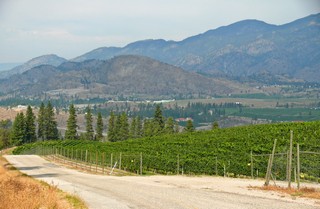
We drove back north to Penticton to see the city and then travelled back by some side roads so we could see the areas away from the river valley.
There were orchards and vineyards in every pocket of fertile land. Many of the vineyards had double high fences. We wondered if it was to protect the harvest from poachers – found out it was to protect the harvest from deer.
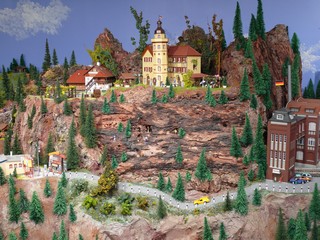
Continuing our travels, the morning of Aug. 18th, we passed through Osoyoos, where we visited the Osoyoos Desert Model Railroad. It’s listed as “The Biggest Little European Railway in Canada”. I bet it is. It’s 3,500 sq. ft. with more than 9,000 hand painted little people, 1,200 buildings and at least twenty computer-controlled trains, running through the layout. There are towns and farms and mountains and forests and rivers with bridges and winter scenes with ski lifts (that work) and summer scenes. It’s amazing and it’s all done by one family. They aren’t even finished yet.
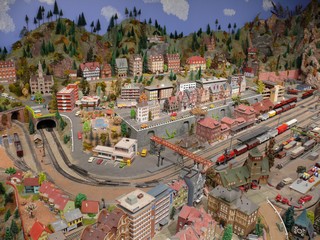
I guess what amazed us most was that the hand-painted little people – around 9,500 – are all done by Ulla Pedersen. She is confined to a wheelchair because of rheumatic arthritis and also has extensive arthritis in her hands. Just amazing!
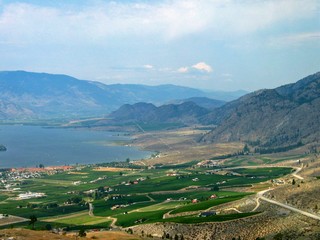 Our final look at the southern Okanagan valley was from a viewpoint part way up the loooooong pull out of the valley – an 8% climb for 15 km.
Our final look at the southern Okanagan valley was from a viewpoint part way up the loooooong pull out of the valley – an 8% climb for 15 km.
Our route was the Crowsnest Highway which runs east along the southern border of British Columbia. In the times we have been in BC we have never travelled BC’s Hwy 3, so this was new country.
We stopped in Grand Forks overnight and had dinner with friends then visited the farmers market in the morning before continuing.
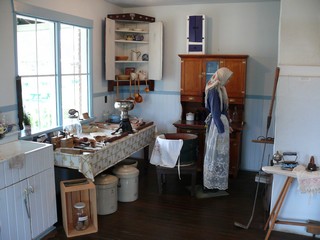
We reached Castlegar, which is situated on the Columbia River, that afternoon and after touring the town and getting an oil change for the truck, we visited the Doukhobor Discovery Centre. It’s a replica of a communal settlement of the pacifist group of about 5,000 Russian immigrants, who settled in the area around 1908–13. It was an interesting visit and we learned many things about this community of people who still reside in southern BC.
Next destination was Creston, around 150 km (90 miles) to meet up with Tony & Heather, our English RV friends. They were heading west and we were heading east and we hadn’t seen them since we spent time together last January in New Mexico.
Leaving Castlegar we travelled straight south to Trail, BC where we had made reservations to take a tour of one of the largest lead-zinc smelters in the world – Teck Cominco. No pictures, as cameras were not allowed inside. From its start in 1896, the smelter has outlived all of the mines in the area (the Sullivan mine closed in 2001 after producing for 92 years) But, since it has its own hydroelectric dam and transmission systems as well as one of the world’s largest fully integrated zinc and lead smelting and refining complexes, it survives. In fact, high quality concentrate is shipped from the Red Dog Mine, in Northwest Alaska, for further refining.
The refinery is a major force in the community, employing about 1,500 staff. One of the most interesting facts about the processes, is that 100% of the products and byproducts are used. They reuse, recycle and have found markets for everything.
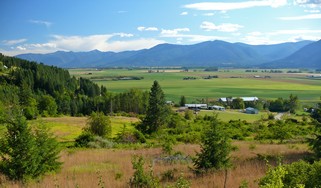
This south-east corner of British Columbia is known as the Kootenay Rockies and is defined by an array of mountain ranges repeating westward from the Continental Divide. We experienced these ranges as we came over a number of passes, the final one being Kootenay Pass. It was another looong and steep pull to get over it.
Creston sits along side the broad, very fertile valley of the Kootenay River, south of Kootenay Lake. In the 30’s about 20,000 acres of land were reclaimed from the Kootenay Delta.
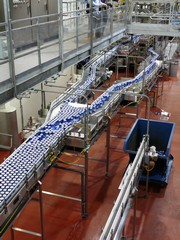
The following day, the four of us took a tour of Columbia Brewing Co., makers of Kokanee Beer which apparently is B.C.’s most popular beer. Everything is totally automated and we followed the whole process right from the mash to the cases on the shipping dock.
After that visit, we drove across town and toured a candle making operation, where everything is still hand done.
In the afternoon, we hiked some of the trails in the Wildlife Management area. It’s a 17,300 acre managed waterfowl habitat located in the Kootenay Delta. There weren’t many birds around but we did get to see a great horned owl perched in one of the trees – and it was a beautiful day!
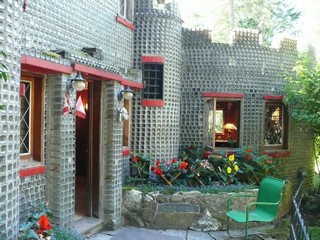
The next day we drove north along the east side of Kootenay Lake to see the Glass House.
It was built from over half a million discarded square-shaped embalming fluid bottles. Interestingly, they apparently weren’t washed as you can still see remnants of the fluid inside some of then.
A Mr. Brown, in 1952, retired from the funeral business, decided that he would find a practical use for the bottles which he collected from around Western Canada.
The house is 48’ by 24’ and with the upstairs room is 1,200 sq. ft. of floor space. It is still lived in by the family and they give tours (for a fee of course).
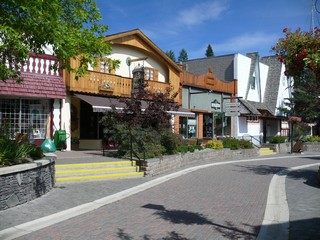
We said goodbye to Tony & Heather and continued east to Cranbrook, the largest city in the Kootenay Rockies. It’s only a little over 100 km so we arrived at our RV park early in the afternoon and decided to visit the town of Kimberly about 30 km away. From there the view of the Rocky Mountains to the east is impressive. The town is based on an alpine theme and the whole downtown core is pedestrian only.
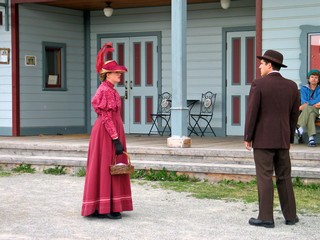 Just north west of Cranbrook, is the living museum of Fort Steele. It is a completely reconstructed frontier town with costumed townspeople continuously acting their parts. The original settlement dates back to the 1860s, and was a ferry crossing. It’s named after the Northwest Mounted Police Superintendent, Sam Steele. We spent a whole day there and didn’t see it all, so came back the next morning with the trailer, on our way to the Crowsnest Pass and Alberta.
Just north west of Cranbrook, is the living museum of Fort Steele. It is a completely reconstructed frontier town with costumed townspeople continuously acting their parts. The original settlement dates back to the 1860s, and was a ferry crossing. It’s named after the Northwest Mounted Police Superintendent, Sam Steele. We spent a whole day there and didn’t see it all, so came back the next morning with the trailer, on our way to the Crowsnest Pass and Alberta.
The Crowsnest Pass, in the Canadian Rockies, was opened in 1897 when the Canadian Pacific Railway built a line through it to develop coal deposits in the Elk river valley and to help assert Canadian sovereignty in an area that U.S. railroads were beginning to 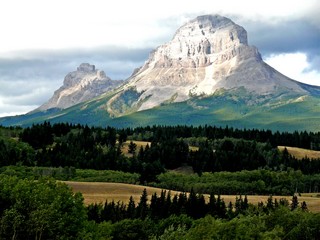 build into. It is the lowest elevation mountain pass in Canada south of the Yellowhead Pass just west of Jasper. After the passes that we had just come over in the past few days, it was very tame.
build into. It is the lowest elevation mountain pass in Canada south of the Yellowhead Pass just west of Jasper. After the passes that we had just come over in the past few days, it was very tame.
This is Crow’s Nest Mountain, as seen from the Alberta Visitor Centre, just after we topped the pass and crossed the Continental Divide. The mountain was named by the Cree Indians because of the many ravens nesting around it.
Our stop for the next few days was Blairmore, in the community of Crowsnest Pass – but more of that in the next journal.
Bernie & Ross
Posted by Bernice at August 25, 2008 05:12 PM
Comments
Awesome as usual. I still say you guys could give lectures on cruise ships.
I would carry the luggage.
Enjoy Vegas.
Best regards,
J & A
Posted by: Jill & Alan at November 3, 2008 05:25 PM
We have been through much of that country--actually all of if but did not have the time to see the museums and special places that you did. That whole valley and then over to Castlegar, Creston, etc is quite amazing. Hopefully, we may make there again with more time but next year are doing Vancouver Island. I agree with the people above--you could give lectures on cruise ships, special tours, etc. Sincerely, Bette
Posted by: Bette Andrew at November 6, 2008 06:08 PM